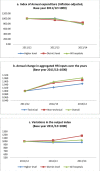Productivity of public hospitals in Nepal: a data envelopment analysis
- PMID: 28729314
- PMCID: PMC5642787
- DOI: 10.1136/bmjopen-2016-015327
Productivity of public hospitals in Nepal: a data envelopment analysis
Abstract
Objectives: Public hospitals in Nepal account for a major share of the total health budget. Therefore, questions are often asked about the performance of these hospitals. Existing measures of performance are limited to historical ratio analyses without any benchmarks. The objective of this study is to explore the trends in inputs, outputs and productivity changes in Nepalese public hospitals from 2011-2012 to 2013-2014.
Setting and participants: The study was conducted among 32 Nepalese public hospitals (23 district level and 9 higher level) for the three fiscal years from 2011-2012 to 2013-2014.
Outcome measures: First, basic ratio analyses were conducted for the input and output measures over the study years. Then, Malmquist productivity change scores were obtained using data envelopment analysis. Aggregated as well as separate analyses were conducted for district level and higher level hospitals.
Results: Real expenditures of the sampled hospitals declined over the 3-year period from an average of US$ 371 000 in year 1 to US$ 368 730 in year 2 and US$ 328680 in year 3. The average aggregated hospital outputs increased marginally from 8276 in 2011-2012 to 8613 in 2013-2014. The total factor productivity of the study hospitals declined by 6.9% annually from 2011-2012 to 2013-2014. Of the total 32 hospitals, productivity increased in only 12 (37.5%) hospitals and declined in the remaining 20 hospitals. The total factor productivity loss was influenced by a decline in technology change, despite an increase in efficiency.
Conclusions: In general, productivity of the study hospitals declined over the study period. Availability and accessibility of accurate, detailed and consistent measures of hospital inputs and outputs is a major challenge for this type of analysis.
Keywords: Data Envelopment Analysis; Hospital; Nepal; Productivity.
© Article author(s) (or their employer(s) unless otherwise stated in the text of the article) 2017. All rights reserved. No commercial use is permitted unless otherwise expressly granted.
Conflict of interest statement
Competing interests: None declared.
Figures
Similar articles
-
Efficiency and Productivity of County-level Public Hospitals Based on the Data Envelopment Analysis Model and Malmquist Index in Anhui, China.Chin Med J (Engl). 2017 Dec 5;130(23):2836-2843. doi: 10.4103/0366-6999.219148. Chin Med J (Engl). 2017. PMID: 29176142 Free PMC article.
-
Efficiency and productivity of hospitals in Vietnam.J Health Organ Manag. 2011;25(2):195-213. doi: 10.1108/14777261111134428. J Health Organ Manag. 2011. PMID: 21845991
-
Bootstrapping data envelopment analysis of efficiency and productivity of county public hospitals in Eastern, Central, and Western China after the public hospital reform.J Huazhong Univ Sci Technolog Med Sci. 2017 Oct;37(5):681-692. doi: 10.1007/s11596-017-1789-6. Epub 2017 Oct 20. J Huazhong Univ Sci Technolog Med Sci. 2017. PMID: 29058280
-
[Technical efficiency of traditional hospitals and public enterprises in Andalusia (Spain)].Gac Sanit. 2015 Jul-Aug;29(4):274-81. doi: 10.1016/j.gaceta.2015.03.001. Epub 2015 Apr 11. Gac Sanit. 2015. PMID: 25869155 Spanish.
-
A window-DEA based efficiency evaluation of the public hospital sector in Greece during the 5-year economic crisis.PLoS One. 2017 May 23;12(5):e0177946. doi: 10.1371/journal.pone.0177946. eCollection 2017. PLoS One. 2017. PMID: 28542362 Free PMC article.
Cited by
-
Efficiency of malaria service delivery in selected district-level hospitals in Ghana.Health Syst (Basingstoke). 2021 Dec 30;12(2):198-207. doi: 10.1080/20476965.2021.2015251. eCollection 2023. Health Syst (Basingstoke). 2021. PMID: 37234466 Free PMC article.
-
Assessing frontline HIV service provider efficiency using data envelopment analysis: a case study of Philippine social hygiene clinics (SHCs).BMC Health Serv Res. 2019 Jun 24;19(1):415. doi: 10.1186/s12913-019-4163-5. BMC Health Serv Res. 2019. PMID: 31234853 Free PMC article.
-
Integrated Analysis of Healthcare Efficiency: A Systematic Review.J Med Syst. 2017 Nov 22;42(1):8. doi: 10.1007/s10916-017-0848-7. J Med Syst. 2017. PMID: 29167999
-
"Recovering, not recovered" Hospital disaster resilience: a case-study from the 2015 earthquake in Nepal.Glob Health Action. 2022 Dec 31;15(1):2013597. doi: 10.1080/16549716.2021.2013597. Glob Health Action. 2022. PMID: 35138232 Free PMC article.
-
Evaluating hospital performance with additive DEA and MPI: the Isfahan University of Medical Science case study.BMC Health Serv Res. 2025 Jan 2;25(1):5. doi: 10.1186/s12913-024-12145-y. BMC Health Serv Res. 2025. PMID: 39748389 Free PMC article.
References
-
- Newbrander W, Barnum H, Kutzin J. Hospital economics and financing in developing countries. Geneva: World Health Organisation, 1992.
-
- Steering Committee for the Review of Commonwealth/State Service Provision. Data Envelopment analysis: a technique for measuring the efficiency of government service delivery. AGPS, Canberra: Industry Commission, 1997.
-
- Smith PC, Mossialos E, Papanicolas I. Performance measurement for health system improvement: experiences, challenges and prospects WHO European Ministerial Conference on Health Systems: "Health Systems, Health and Wealth". Tallinn, Estonia: WHO Regional Office for Europe, 2008:1–18.
-
- Prasai DP. A review of studies on Nepal's National Free Health Care Programme. Kathmandu, Nepal: Primary Health Care Revitalization Division, DoHS, MoHP, 2013.
MeSH terms
LinkOut - more resources
Full Text Sources
Other Literature Sources

